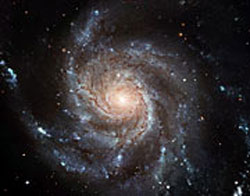Largest ever galaxy portrait — stunning HD image of Pinwheel Gala

This new Hubble image reveals the gigantic Pinwheel galaxy, one of the best known examples of “grand design spirals”, and its supergiant star-forming regions in unprecedented detail. The image is the largest and most detailed photo of a spiral galaxy ever released.
Giant galaxies weren’t assembled in a day. Neither was this Hubble Space Telescope image of the face-on spiral galaxy Messier 101 (the Pinwheel Galaxy). It is the largest and most detailed photo of a spiral galaxy beyond the Milky Way that has ever been publicly released. The galaxy’s portrait is actually composed from 51 individual Hubble exposures, in addition to elements from images from ground-based photos. The final composite image measures a whopping 16,000 by 12,000 pixels.
The Hubble observations that went into assembling this image composite were retrieved from the Hubble archive and were originally acquired for a range of Hubble projects: determining the expansion rate of the universe; studying the formation of star clusters in giant starbirth regions; finding the stars responsible for intense X-ray emission and discovering blue supergiant stars. As an example of the many treasures hiding in this immense image, a group led by K.D. Kuntz (Johns Hopkins University and NASA) recently catalogued nearly 3000 previously undetected star clusters in it.
The giant spiral disk of stars, dust and gas is 170,000 light-years across or nearly twice the diameter of our Milky Way. The galaxy is estimated to contain at least one trillion stars. Approximately 100 billion of these stars alone might be like our Sun in terms of temperature and lifetime. Hubble’s high resolution reveals millions of the galaxy’s individual stars in this image.
The Pinwheel’s spiral arms are sprinkled with large regions of star-forming nebulae. These nebulae are areas of intense star formation within molecular hydrogen clouds. Brilliant young clusters of sizzling newborn blue stars trace out the spiral arms. The disk of the galaxy is so thin that Hubble easily sees many more distant galaxies lying behind the foreground galaxy.
The Pinwheel Galaxy lies in the northern circumpolar constellation, Ursa Major (The Great Bear) at a distance of 25 million light-years from Earth. We are seeing the galaxy from Earth today as it was at the beginning of Earth’s Miocene Period when mammals flourished and the Mastodon first appeared on Earth. The galaxy fills an area on the sky of one-fifth the area of the full moon.
The newly composed image was assembled from archived Hubble images taken with the Advanced Camera for Surveys and the Wide Field and Planetary Camera 2 over nearly 10 years: in March 1994, September 1994, June 1999, November 2002 and January 2003. The Hubble exposures have been superimposed onto ground-based images, visible at the edge of the image, taken at the Canada-France-Hawaii Telescope in Hawaii, and at the 0.9-meter telescope at Kitt Peak National Observatory, part of the National Optical Astronomy Observatory in Arizona. Exposures taken through a blue filter are shown in blue, through a green filter in green and through a red filter in red.
Media Contact
More Information:
http://www.spacetelescope.org/news/html/heic0602.htmlAll latest news from the category: Physics and Astronomy
This area deals with the fundamental laws and building blocks of nature and how they interact, the properties and the behavior of matter, and research into space and time and their structures.
innovations-report provides in-depth reports and articles on subjects such as astrophysics, laser technologies, nuclear, quantum, particle and solid-state physics, nanotechnologies, planetary research and findings (Mars, Venus) and developments related to the Hubble Telescope.
Newest articles

Silicon Carbide Innovation Alliance to drive industrial-scale semiconductor work
Known for its ability to withstand extreme environments and high voltages, silicon carbide (SiC) is a semiconducting material made up of silicon and carbon atoms arranged into crystals that is…

New SPECT/CT technique shows impressive biomarker identification
…offers increased access for prostate cancer patients. A novel SPECT/CT acquisition method can accurately detect radiopharmaceutical biodistribution in a convenient manner for prostate cancer patients, opening the door for more…

How 3D printers can give robots a soft touch
Soft skin coverings and touch sensors have emerged as a promising feature for robots that are both safer and more intuitive for human interaction, but they are expensive and difficult…





















